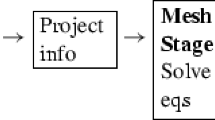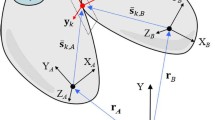Abstract
A fixed-point fluid–structure interaction (FSI) solver with dynamic relaxation is revisited. New developments and insights gained in recent years motivated us to present an FSI solver with simplicity and robustness in a wide range of applications. Particular emphasis is placed on the calculation of the relaxation parameter by both Aitken’s \({\Delta^{2}}\) method and the method of steepest descent. These methods have shown to be crucial ingredients for efficient FSI simulations.
Similar content being viewed by others
References
Badia S, Codina R (2007) On some fluid–structure iterative algorithms using pressure segregation methods. application to aeroelasticity. Int J Numer Methods Eng 72(1): 46–71
Bazilevs Y, Calo VM, Zhang Y, Hughes TJR (2006) Isogeometric fluid–structure interaction analysis with applications to arterial blood flow. Comput Mech 38(4–5): 310–322
Causin P, Gerbeau J-F, Nobile F (2005) Added-mass effect in the design of partitioned algorithms for fluid-structure problems. Comput Methods Appl Mech Eng 194: 4506–4527
Chung J, Hulbert GM (1993) A time integration algorithm for structural dynamics with improved numerical dissipation: the generalized-\({\alpha}\) method. J Appl Math 60: 371–375
Deparis S (2004) Numerical analysis of axisymmetric flows and methods for fluid–structure interaction arising in blood flow simulation. Dissertation, EPFL
Deparis S, Discacciati M, Fourestey G, Quarteroni A (2006) Fluid–structure algorithms based on Steklov-Poincaré operators. Comput Methods Appl Mech Eng 195: 5797–5812
Dettmer WG, Peric D (2006) A computational framework for fluid–structure interaction: finite element formulation and applications. Comput Methods Appl Mech Eng 195: 5754–5779
Farhat C (2004) CFD-based nonlinear computational aeroelasticity. In: Stein E, De Borst R, Hughes TJR(eds) Encyclopedia of Computational mechanics, vol 3, chap. 13. Wiley, NY
Farhat C, Geuzaine P (2004) Design and analysis of robust ale time-integrators for the solution of unsteady flow problems on moving grids. Comput Methods Appl Mech Eng 193: 4073–4095
Fernández MÁ, Moubachir M (2005) A Newton method using exact jacobians for solving fluid–structure coupling. Comput Struct 83(2–3): 127–142
Förster Ch (2007) Robust methods for fluid–structure interaction with stabilised finite elements. Dissertation, Institut für Baustatik und Baudynamik Universität Stuttgart
Förster Ch, Wall WA, Ramm E (2005) On the geometric conservation law in transient flow calculations on deforming domains. Int J Numer Methods Fluids 50: 1369–1379
Förster Ch, Wall WA, Ramm E (2007) Artificial added mass instabilities in sequential staggered coupling of nonlinear structures and incompressible viscous flows. Comput Methods Appl Mech Eng 196: 1278–1293
Förster Ch, Wall WA, Ramm E (2008) Stabilized finite element formulation for incompressible flow on distorted meshes. Int J Numer Methods Fluids (in press)
Gerbeau J-F, Vidrascu M (2003) A quasi-Newton algorithm based on a reduced model for fluid–structure interaction problems in blood flows. Math Model Numer Anal. Math Model Numer Anal 37(4): 631–647
Gerbeau J-F, Vidrascu M, Frey P (2005) Fluid–structure interaction in blood flows on geometries coming from medical imaging. Comput Struct 83: 155–165
Golub GH, Van Loan CF (1996) Matrix computations. The Johns Hopkins University Press, Baltimore
Heil M (2004) An efficient solver for the fully coupled solution of large-displacement fluid–structure interaction problems. Comput Methods Appl Mech Eng 193: 1–23
Hübner B, Walhorn E, Dinkler D (2004) A monolithic approach to fluid–structure interaction using space-time finite elements. Comput Methods Appl Mech Eng 193: 2087–2104
Irons B, Tuck RC (1969) A version of the Aitken accelerator for computer implementation. Int J Numer Methods Eng 1: 275–277
Kalro V, Tezduyar TE (2000) A parallel 3d computational method for fluid–structure interactions in parachute systems. Comput Methods Appl Mech Eng 190: 321–332
Kelley CT (1995) Iterative Methods for linear and nonlinear equations frontiers in applied mathematics. SIAM
Knoll DA, Keyes DE (2004) Jacobian-free Newton-Krylov methods: a survey of approaches and applications. J Comput Phys 193: 357–397
Küttler U, Förster Ch, Wall WA (2006) A solution for the incompressibility dilemma in partitioned fluid–structure interaction with pure Dirichlet fluid domains. Comput Mech 38: 417–429
Matthies HG, Steindorf J (2003) Partitioned strong coupling algorithms for fluid–structure interaction. Comput Struct 81: 805–812
Michler C, Brummelen EH, Borst R (2005) An interface Newton-Krylov solver for fluid–structure interaction. Int J Numer Methods Fluids 47: 1189–1195
Mok DP, Wall WA (2001) Partitioned analysis schemes for the transient interaction of incompressible flows and nonlinear flexible structures. In: Wall WA, Bletzinger K-U, Schweitzerhof K (eds) Trends in computational structural mechanics
Park KC, Felippa CA, Ohayon R (2001) Partitioned formulation of internal fluid–structure interaction problems by localized Lagrange multipliers. Comput Methods Appl Mech Eng 190(24–25): 2989–3007
Quaini A, Quarteroni A (2007) A semi-implicit approach for fluid–structure interaction based on an algebraic fractional step method. Math Models Methods Appl Sci 17(6): 957–983
Le Tallec P, Mouro J (2001) Fluid structure interaction with large structural displacements. Comput Methods Appl Mech Eng 190(24–25): 3039–3067
Tezduyar TE (2007) Finite elements in fluids: Special methods and enhanced solution techniques. Comput Fluids 36: 207–223
Tezduyar TE (2007) Finite elements in fluids: stabilized formulations and moving boundaries and interfaces. Comput Fluids 36: 191–206
Tezduyar TE, Sathe S (2007) Modelling of fluid–structure interactions with the space-time finite elements: solution techniques. Int J Numer Meth Fluids 54(6–8): 855–900
Tezduyar TE, Sathe S, Cragin T, Nanna B, Conklin BS, Pausewang J, Schwaab M (2007) Modelling of fluid–structure interactions with the space-time finite elements: arterial fluid mechanics. Int J Numer Meth Fluids 54(6–8): 901–922
Tezduyar TE, Sathe S, Keedy R, Stein K (2006) Space-time finite element techniques for computation of fluid–structure interactions. Comput Methods Appl Mech Eng 195: 2002–2027
Tezduyar TE, Sathe S, Stein K (2006) Solution techniques for the fully-discretized equations in computation of fluid–structure interactions with the space–time formulations. Comput Methods Appl Mech Eng 195: 5743–5753
Vierendeels J (2005) Implicit coupling of partitioned fluid–structure interaction solvers using a reduced order model. AIAA Fluid Dyn Conf Exhib 35: 1–12
Wall WA (1999) Fluid-Struktur-Interaktion mit stabilisierten Finiten Elementen. Dissertation, Institut für Baustatik, Universität Stuttgart
Wall WA, Gerstenberger A, Gamnitzer P, Förster Ch, Ramm F (2006) Large deformation fluid–structure interaction—advances in ALE methods and new fixed grid approaches. In: Bungartz H-J, Schäfer M(eds) Fluid–structure interaction: modelling, simulation, optimisation, LNCSE. Springer, Heidelberg
Wall WA, Mok DP, Ramm E (1999) Partitioned analysis approach of the transient coupled response of viscous fluids and flexible structures. In: Wunderlich W (Ed.), Solids, structures and coupled problems in engineering, proceedings of the European conference on computational mechanics ECCM ’99, Munich
Wüchner R, Kupzok A, Bletzinger K-U (2007) A framework for stabilized partitioned analysis of thin membrane-wind interaction. Int J Numer Methods Fluids 54(6–8)
Author information
Authors and Affiliations
Corresponding author
Rights and permissions
About this article
Cite this article
Küttler, U., Wall, W.A. Fixed-point fluid–structure interaction solvers with dynamic relaxation. Comput Mech 43, 61–72 (2008). https://doi.org/10.1007/s00466-008-0255-5
Received:
Accepted:
Published:
Issue Date:
DOI: https://doi.org/10.1007/s00466-008-0255-5




